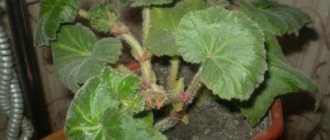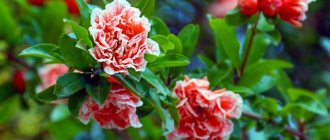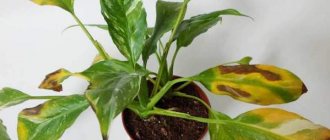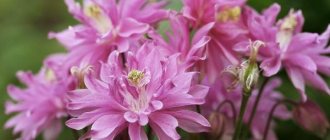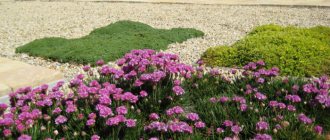Types and varieties of blueberries
Scylla is a flower with a wide variety of varieties (about 90). The types below are the most popular among gardeners.
| Variety | Description |
| Campanulate | It is most common in garden plots. The plant has a short stem (about 30 cm), on which from 5 to 10 bells can be located. |
| Hyacinth-shaped | It is characterized by a high density of inflorescences. This variety is often used for decorative purposes. |
| Siberian | The color range is varied: ovoid flowers can be pinkish, white or blue. The height of the stem is small, about 10 cm. |
| Grape | It is also sometimes called "Peruvian", native to the western edges of the Mediterranean Sea. These plants are distinguished by the presence of fairly large cone-shaped inflorescences of blue color. The leaves have a linear shape and taper towards the end. |
| Bifolia | Relatively low, about 15 cm. The shape of the flowers resembles stars and is blue, pink or white. |
| Proleskovidnaya | It blooms twice a year: in July and early autumn (from late August to October). Decorated with many small flowers of soft pink color. |
| Autumn | It has 5-6 light purple flowers and a cone-shaped inflorescence. The stem length is about 20 cm. |
| Italian | The ovoid shape of the bulb, long leaves pointed at the ends and a large number of pale blue flowers on a long stem. |
| Lithardier | The inflorescence has an oval shape with many light purple flowers. It blooms in July and, despite its rather attractive appearance, is not as popular as other scilla varieties. |
| Pushkiniformnaya | It got its name for its similarity with another flower - Pushkinia. It is considered one of the most persistent and undemanding; it has a not very long stem (about 15 cm). The leaves are linear, widening towards the middle. The racemose inflorescence contains no more than 10 pale blue flowers. Flowering occurs at the beginning of May. |
Planting and propagation of scillas
The scilla plant can grow in open space and in the partial shade of trees, especially deciduous ones. In the sun, mostly meadow woodlands live. Hot areas are preferred by Pushkinia and autumn woodlands. If you plant them on a personal plot, you should prepare high beds for planting.
Scylla prefers soil that is nutritious, containing leaf humus and mineral fertilizers in the soil. The composition of the earth can be any. The exception is acidic soil. Keep the step between bushes up to 10 cm. The planting depth should be the same as the height of the bulb.
Reproduction by baby bulbs:
- a bush for propagation is selected no earlier than 3 years;
- carefully disconnect the babies, there are at least four of them near the mother’s bulb;
- plant in a permanent place;
- add soil mixed with mineral components and leaf humus to the hole;
- baby bulbs are planted at a growth depth;
- carry out the propagation procedure as soon as the leaves die;
- the bulbs can also be planted in boxes and stored in a cool place until autumn if propagation occurs in the spring;
- in September they are planted in open ground;
- care is the same as for adult specimens.
Propagation by seeds is carried out using freshly harvested planting material. Although this is not necessary. Scilla reproduces well by self-seeding.
If you don’t like the way the bushes are scattered around the garden, you can plant them in the place that is considered more profitable for you. Transplanting even in bloom will not harm them. Flowering from planting seeds will occur in the 3rd year.
There is another propagation method - cutting off the bottom of the bulb. This method uses containers. When small babies appear on the bottom, they are carefully separated with tweezers and transplanted for rearing. In the fall, they are planted in a permanent place.
Scilla bifolia, Siberian, is planted in flowerpots for forcing. For this, the soil is prepared: peat, humus and drainage. A large and strong bulb sits in a pot in November.
The container is sent to a dark place with an ambient temperature of 5 degrees C for several months. After 60 days, the bulb is taken out to a bright place, fed, watering is resumed, but the temperature should be 15 degrees C. In the spring, the plant will bloom.
Caring for blueberries
Scylla requires the following care:
- Watering should be done moderately in the morning. Overwatering is detrimental to bulbs. When irrigating, do not spray the plant; try to spray it directly onto the soil.
- Cover the ground with a layer of mulch to retain moisture and nutrients. It is worth paying attention that the plant does not like acidic soil. Therefore, do not use elements that increase acidity, such as pine needles, as mulch.
- Scylla responds well to feeding. The decorative appearance of the bushes greatly benefits and is protected from diseases. Use mineral components as fertilizers before flowering in spring (nitrophoska) or autumn. Moreover, use granules in the fall, and liquid fertilizers in the summer.
- Transfer. Species may differ in flowering time. They are replanted in the spring, usually by those species that bloom at this time. The procedure begins after the leaves die off. If flowering occurs in autumn, transplantation is carried out 30 days before.
Diseases and pests:
- Gray rot. Symptoms: a gray coating appears on the leaves and the top of the bulb. Control: remove diseased specimens, cut off affected areas of the bulb, grease with ash. If the stage is advanced, use fungicides.
- Mouse-like rodents. They gnaw off the leaves in the spring and eat the onion. For such pests, a fence will help, where you scatter bait around the perimeter and dig it in a little with soil. Otherwise, you can poison the birds.
- Meadow bream. Drinks juice from an onion. Fight it with insecticides, and for preventive purposes, treat the bulbs with Akarin before planting.
Planting in open ground
As a rule, scylla is not planted individually: the plants are collected in flower beds or distributed around trees.
Time
Experienced gardeners recommend replanting spring scylla in open ground in mid-June, and autumn scylla - towards the end of August.
Place
You can plant flowers on both the sunny and shady sides. It all depends on the variety and flowering time: spring species prefer warmth and sun, while autumn species feel better in the shade and coolness.
During rainy or cool days, Scylla leaves are arranged horizontally and almost lie on the ground, while in sunny weather they stand vertically.
Botanical description of the Scilla flower
Scilla plant or Scilla is a perennial bulbous crop belonging to the Asparagus family. The plant genus includes more than 80 species, widespread in European, Asian, and African countries.
Thanks to its unpretentiousness and ability to adapt to the environment, the scilla plant reproduces quickly and is practically not susceptible to disease.
Most plant varieties have low or medium growth (up to 30-35 cm), but there are varieties whose height can reach a meter.
The rich green leaves of the plant are collected in a basal rosette and have an oblong shape. They usually appear on the soil surface at the same time as the peduncle, or a little earlier. Small single flowers are collected in racemose inflorescences located on a long, smooth and strong peduncle. The most common blue species, but there are varieties with snow-white, purple, pink, and blue petals. Most varieties bloom in early spring, but there are also those whose flowering period occurs at the end of summer and beginning of autumn.
After flowering, a fruit capsule is formed, which contains small black ovoid seeds. The bulbs have a round, ovoid shape, the color of the outer shell varies from purple to brown.
Care
Due to the fact that scylla is a picky plant, it only needs systematic watering and loosening of the soil. Weed control is also important.
The most successful time for watering is considered to be morning, the main thing is that the flowers are not flooded with water, otherwise it will have a bad effect on their appearance.
Don’t forget that blueberries reproduce from flowers, so their seeds need to be removed if the gardener does not want the flowers to spread to places not intended for this purpose.
It is better to fertilize when a particular species is in bloom, for example, spring plants are fed in early spring, and autumn plants in late August-early September.
Species diversity of Scylla
As we have already mentioned, the flower has a wide variety of species. Let us dwell on several types that are distinguished by the greatest decorative effect.
Scilla bifolia
Medium-sized species, shoot height reaches 15-20 cm. It has two wide-line leaves, about 5 cm wide.
Photo of Scilla bifolia
The color of the petals is blue or purple-blue. The flowers are star-shaped, collected in racemes of ten pieces. Widely distributed throughout European countries.
Siberian blueberry (Scilla siberica)
The most common species in the CIS countries. The number of leaves varies from two to four.
Siberian Scilla
The flowers are drooping, cup-shaped, collected in inflorescences of 4-5 pieces. Petals are bright blue. The height of the bush is up to twenty centimeters. Thanks to selection, a large number of varieties have been developed, among which there are specimens with snow-white, dark blue inflorescences.
Bluebell or Spanish Scilla flower (Scilla hispanica)
A tall species, the height of its shoots reaches forty centimeters.
Scilla bell-shaped (Spanish)
The width of the bush is about ten centimeters. It develops quickly and grows well. The foliage is dark green and shiny. The flowers are shaped like a small bell (diameter about 2 cm). The racemose inflorescence consists of 10-15 flowers. Depending on the variety, the petals can be snow-white, pink-violet, blue-violet.
Scilla peruviana flower
The height of the crop reaches 30 cm, the width is about 10 cm. It is distinguished by the presence of abundant foliage - up to 15 leaves per bush.
Scilla Peruvian
The leaves remain year-round, dying off with the appearance of new leaf blades. Flowers are collected in lush inflorescences of 50-100 pieces. Depending on the variety, the petals can be blue, white, or dark purple. The flowering period begins in the summer.
Reproduction
To reproduce, you will need Scylla seeds or babies. In addition to the method described above, you can propagate the plant using seeds, which must first be prepared.
You need to collect seed boxes towards the end of June, when they become yellow and crack. The seeds are taken out of them and immediately planted in the designated place. But since the seeds are difficult to germinate, this method is not the fastest for growing. You will have to see the first flowers no earlier than after 3 years.
Pests and diseases of the Scilla flower
It is worth noting that the Scylla flower is quite resistant to various diseases, but some diseases caused by improper care are still inherent in it.
Thus, an abundance of moisture in the soil can lead to the appearance of fungal infections, which will result in rotting of the bulbs. The first signs of the disease are yellowing of the foliage and drying out of the peduncle. By affecting the bulb, the disease leads to the death of the flower.
Dead flowers must be burned and the soil treated with a fungicide. Only after treatment is the soil suitable for subsequent planting.
Scilla flower can also be affected by root mite, the larvae of which grow inside the bulb. You can combat plant infestation with mites by treating the soil with an insecticide. The mulch used to cover the planting should also be disinfected before spreading the soil.
In garden conditions, tubers can suffer from mice that feast on the rhizome. You can prevent rodents by planting tubers in special metal bags. They go deep into the ground when planting bulbs and serve as reliable protection against mice.
Diseases and pests
When a scilla is infected with Achellenchoides, the surface of the bulb becomes brown in color. Sick plants not only lose their visual attractiveness, but also begin to lag significantly behind in development. Affected bushes are dug up and burned.
Mold appears on scylla infected with gray mold, which subsequently begins to rot. As the disease progresses, the bushes turn yellow and die. Such plants need to be urgently dug up and burned.
The plant becomes infected with bulb rot at high air humidity. The first signs are that the bush turns yellow and the bulbs begin to become covered with brown spots.
It is very simple to understand that a plant has been attacked by a meadow root mite. Due to the fact that the pest gnaws the bottom of the bulb and penetrates inside, sucking the juice out of the scylla, it first dries out, then rots and eventually dies.
To get rid of a tick, you need to purchase a special solution at a gardening store and spray the affected bush.
Caring for blueberries
Scilla are frost-resistant, they have excellent immunity and perfectly adapt to any environmental conditions. And this is another reason for their popularity among gardeners!
Temperature and lighting
Spring species of woodlands especially need good lighting. They are completely unpretentious to our temperatures, but without light they will not grow normally. But some summer and autumn varieties prefer partial shade.
Photo: cvetyphoto.blogspot.com
Watering
Scilla loves high humidity, but does not tolerate floods and stagnant water. You need to water the flowering flower bed very carefully so as not to touch the flowers.
Photo: oir.mobi
The soil
The soil needs to be loose, rich in organic matter, slightly moist, with leaves and bark. Almost like being in a forest! Looseness is the main requirement, because if the soil does not allow water to pass through well, the bulbs will begin to rot.
Photo: flo.discus-club.ru
Fertilizers and fertilizing
In order for the garden scilla to bloom for a really long time, abundantly and evenly, it needs fertilizing. Of course, she can cope without them, like her forest relatives, but the decorative effect suffers significantly. Use liquid mineral fertilizers in the spring, and slowly soluble granules in the fall.
Photo: ogorodniki.com
Wintering
Immediately after flowering, cut off the flower stalks, but leave the leaves. They need to be removed when they die off on their own so that the bulb has time to stock up on nutrients. Scilla can overwinter directly in the ground, unless the open areas should be covered with leaves or spruce branches.
Photo: braggartkurtki.ru
Brunner (50 photos): types, care and planting in open ground
Scilla or Scylla in garden landscape design
Thanks to the tenderness of the inflorescences of Scilla, the perennial is widely used to decorate the spring garden. It looks good in single plantings, combining perfectly with the awakening greenery of shrubs and trees. It can also be used to organize group flower beds made up of primroses.
You can create a flower bed from flowers of different flowering times; when the Blue Scilla has faded, another type of plant may bloom in its place, for example, Peony, which will cover the Scilla's planting site with its lush crown.
The Scylla flower looks good cut and in spring bouquets. Its delicate buds and bright greenery will not leave any representative of the fair sex indifferent.
Scilla and its neighbors: combination with other plants
To create compositions, plants that bloom at the same time are selected, compatible with the crop - or contrasting. It is important to take into account that annuals, when they bloom, create empty spaces around the woodland that is not protected from the sun. Planting perennials nearby creates shade and protects the bulbs from overheating in the heat.
Of the perennials, they look spectacular next to ferns and peonies, and others that have not had time to bloom. They also go well with simultaneously blooming snowdrops, crocuses, pushkinias, daffodils and other inhabitants of the bulb garden.
In mixborders and borders, under bushes and in combination with them, in monochrome plantings around trees, under the canopy of a garden - Siberian Scilla is appropriate everywhere. Large group plantings are spectacular, those same blue islands that captivate the eye in the photo. Compositions in combination with stones are good - in the design of an alpine slide and rock garden. Blue-eyes are also appropriate on open lawns and lawns; they are especially expressive among awakening bushes and bare trees.
In general, the touching primrose is unpretentious to grow. It survives on most soils and is stoic about poor soils and poor watering. It propagates easily, especially by self-sowing. It will not tolerate complete indifference to its beauty, but it will respond to the warmth of its owner’s hands with a sea of shy blue-blue flowers.
Scylla sibirica is one of the best varieties of scilla
The variety has special decorative properties. The whole secret lies in the unique color of the blueberry. The bright blue petals with a purple tint have ultramarine stripes in the center. When viewed closely, they resemble a cat's eye. There are up to 4-5 of them in inflorescences.
Other features of the perennial:
- reaches 10-12 cm in height;
- has wide-line leaves of an emerald hue;
- dense peduncles come with a purple tint.
It is by these characteristics that you can recognize the Siberian Scylla. Planting and caring for this variety is no different from ordinary varieties. Partial shade or a sunny area is suitable for its cultivation.
Therefore, seedlings are planted:
- under the trees;
- around bushes;
- on open lawns;
- at the base of rockeries.
The flowering period begins in April and lasts a whole month (15-25 days). Then comes the resting phase, which lasts the whole summer. In autumn, a new process of laying bulbs, leaves and flower stalks begins. During wintering, the herbaceous crop continues to develop.
Siberian bluebell has several subspecies. They are distinguished by the shade of drooping bells: white, blue and pale pink.
The unpretentiousness of bluebell grass impresses many gardeners. Therefore, even if you let everything take its course, you can get a rather spectacular flowerbed in a colonial style, which is characterized by negligence and elegance.
Scilla flower photo
The arrival of spring is always associated with the awakening of nature, the appearance of lush greenery and fragrant inflorescences. One of these harbingers of spring is the Scilla flower, which, thanks to its early flowering, received a second, no less popular, name - blue snowdrop. We suggest studying the features of this plant and the secrets of caring for it.
- Scilla bifolia
Common types of spring bulbs
There are a great variety of bulbous flowers, and breeders are constantly creating new varieties that are distinguished by their special beauty and sophistication.
Snowdrop (Galanthus) is a familiar, one of the first to bloom, delicate white forest flower. He needs no introduction. Thanks to the efforts of breeders, decorative varieties of snowdrops have appeared that differ from their wild relatives.
- Snowdrop Nivalis (Galanthus nivalis) is a common species, growing up to 20 cm in height. The single white bell flowers have a green spot at the end of the outer petals. Decorative varieties of this species: Viridapice, Atkinsii, Sam Arnott and terry variety Flore Pleno.
Snowdrop snowdrop Nivalis “Flore Pleno”
- Elvis's snowdrop (Galanthus elwesii) is the largest species, reaching a height of 50 cm. Very similar to Nivalis, but significantly larger in size. The flowers have a distinctive enchanting honey scent.
- Voronova's snowdrop (Galanthus woronowii) is a variety of Russian selection. Differs in relatively wide leaves. The flowers are small but have cute green touches on the petals. It grows strongly, so division and replanting is necessary approximately every two years.
- The folded snowdrop (Galanthus plicatus) is also a broad-leaved variety; the leaves are green with a grayish tint and have a longitudinal fold.
From the spring blue-blue clearings in the forest, the scilla (Scilla) . However, blueberries can be very diverse; there are several dozen species. Only a few of them are found in our gardens. The color of Scilla flowers can be blue, white, pink and purple.
Siberian bluegrass variety “Spring Beauty”
The most common in our area is the Siberian scilla (Scilla sibirica) with azure bells; it also has a white-flowered variety, and there are also specimens with pink flowers. Among the decorative ones, you can also choose about (Spring Beauty) with strong peduncles and dark purple flowers.
Rosen's Scilla (Scilla roseni) is a very beautiful species with an unusual flower shape. In its natural environment it grows in the mountain meadows of the Caucasus. A plant with one peduncle up to 20 cm. The flower is white and blue (about 5 cm). Its elongated petals are gracefully curved back. It is still rare in our gardens, but it is not capricious and therefore deserves wider distribution.
Breeders have developed hybrids of Scylla with other flowers. These are Scilla campanulata and Scilla puschkinioides.
Very popular bulbous flowers are crocuses, or saffron ( Crocuses ). Crocuses bloom immediately after snowdrops. A characteristic feature of this plant is a very shortened stem; it seems that goblet-shaped flowers of various colors grow directly from the ground (there are also two-color varieties).
One of the first to bloom is the large-flowered Vanguard crocus. Its flowers consist of outer snow-white and inner deep lilac petals. Has a pleasant smell.
The very popular large-flowered variety Jeanne D'Arc will bloom next. These snow-white flowers simply radiate tenderness. Pale lilac strokes are barely visible on the flower tube.
Another variety of crocuses, Cream Beauty, touches with its fragile appearance. It has cute cream flower glasses with a tan neck.
Crocus variety "Angustifolius"
A very original variety of Angustifolius with elongated, pointed petals of a rich yellow color, with dark bronze stripes along the outer petals.
The latest variety is considered Negro Boy, deep purple petals with a light, barely noticeable white stripe along the very edge.
Chionodoxa is a beauty of alpine meadows . These bulbous flowers delight us in the spring with cute bouquets of small stars surrounded by rich green leaves.
- Giant (Chionodoxa gigantea) - this species is distinguished by rather large (up to 4 cm) flowers. Traditionally it is blue in color, but there is a variety with white flowers. (Alba Hort)
Chionodoxa Lucili "Pink Giant"
- Lucili (Chionodoxa luciliae) - its leaves are shorter than the flower stalks, which emphasizes the effect of the bouquet. And in the middle of the bright blue flower there is a blurry white spot. There are varieties with white and pink petals. (Alba Hort, Rosea Witte, Pink Giant, Miss Alice, Pink Queen, Sireneviy tuman)
- Forbes (Chionodoxa forbesii) - this species is distinguished by a large number of flowers and high (up to 30 cm) peduncles. (Pink Giant, Alba, Blue Giant)
- Sardinian (Chionodoxa sardensis) - its dense flower stalks can be used for cutting. Height 12-15 cm. The flowers are bright blue, but there are decorative varieties with pink petals.
- Dwarf (Chionodoxa nana) - its small flowers (no more than 1 cm) are located on peduncles about 10 cm. Rare.
All Chionodoxa are easily pollinated and form interspecific hybrids.
It will be useful to read:
Perennials that bloom all summer Here is a list of the best perennial unpretentious flowers that are ideal for any garden, especially if you...
Muscari , mouse hyacinth, or viper onion ( Muscari ) are probably the most unpretentious bulbous flowers. They are ready to adapt to any conditions and will soon have to cut off dried flowers to avoid its strong spread in the garden. The pretty flowers, slightly reminiscent of hyacinth, have a very pleasant scent. There are many species of this plant, and they are replete with a variety of varieties. But we will focus on the most original ones.
The already quite famous and unusually beautiful variety “Blue Spike” (Muscari armeniacum Blue Spike), its rich blue voluminous flowers make the inflorescence look like lush foam.
The variety “Valerie Finnis” (Muscari armeniacum Valerie Finnis) has an unusual color, its dense cone-shaped inflorescences-spikelets are smoky blue, and at the top of the inflorescence there is a small “tuft” of small flowers.
Muscari variety "Valerie Finnis"
The new variety Pink Sunrise (Muscari armeniacum Pink Sunrise), its delicate pink flowers are pale at first, but gradually become brighter in color.
The exotic muscari comosum Plumosum surprises with shaggy blue-violet flowers, very different from traditional ones. And the muscari variety Golden Fragrance, in addition to unusual tube-shaped flowers, also has a yellow color that is uncharacteristic for its species. The neglected muscari (Muscari neglectum Guss.et Ten) has such a deep purple color that it sometimes appears black.
Muscari "Golden Fragrance"
All these muscari are very frost-resistant and are perfect for our gardens.
The beautiful Pushkinia ( Puschkinia ) is represented by only two species: scilla-like and hyacinth-like. Scilla has only one peduncle, blooms in April, white or blue star-shaped flowers are collected in a loose cluster. And the hyacinth blooms in May, can have up to four peduncles, and is similar to hyacinth. Its flowers are soft blue with a blue stripe in the middle of the petal.
The main bulbous flowers of spring are daffodils ( Narcissus ) and tulips ( Tulip ). Thanks to the efforts of breeders, there are an extraordinary variety of them. According to the type of flower, there are 13 species of daffodils, and 15 of tulips. Let us only note that tulips are species-specific (large with a variety of shapes) and botanical (small and do not require digging). Here every gardener will definitely find suitable specimens.
Both of these plants are quite unpretentious and are grown in almost every garden. Caring for them is similar, but tulips also need to be dug up some time after flowering. You can learn more about this and other subtleties of flower care here.
Tulips
I would like to note that spring flowers and kandyk are rarely found in our gardens.
Kandyk, or erythronium variety “Rose Queen”
Kandyk , or erythronium ( Erythronium ) - the height of this bulbous perennial is up to 35 cm. The leaves of kandyk are very similar to tulips, and the graceful large flowers (5 cm) with petals curved upward are similar to lilies. Flowering begins in mid-spring. Winter-hardy species - Siberian and European. Siberian is distinguished by brown-green marbled leaves and large, charming pinkish-lilac flowers with bright yellow stamens. And the European variety Lilac Wonder has a strong purple tint in the color of the flower, the pink-flowered variety is Rose Queen, and Snowflake is creamy white. These species do not require winter shelter.
Vesennik , or erantis ( Eranthis ) - this plant in appearance is not at all similar to other bulbous plants. Its leaves are palmately divided, the flowers are small (up to 3 cm), most often yellow, and those of Eranthis stellate are white, with a slight purple tint below. This is a forest dweller, so it feels good under trees. It is distinguished by very early flowering, sometimes right from under the snow.
You can’t ignore the tiny iridodictiums ( Iridodictyum ). As soon as the snow melts, dense narrow leaves with several edges appear from under the ground, and a peduncle comes out with them. It is very short in Iridodictium, below the leaves (8-15 cm). The flowers (5-7 cm) are shaped like irises. The large lower petals, like butterfly wings, are spread out to the sides. There are different colors. For example, the JS Dijt variety is reddish-purple, and its large lower wing petals have a pattern of yellow spots, white streaks and black dots. And the Harmony variety has the same pattern, but the color of its petals is deep blue. The popular Danfordiae variety is bright yellow with greenish-brown spots on the lower petals. All these varieties, in addition to the beauty of flowering, will also give you a delicate delicate aroma.
We can continue our list of spring bulbous flowers. However, they bloom already at the border with summer. These are hazel grouse ( Fritillaria ), hyacinths ( Hyacinthus ), ornithogalum ( Ornithogalum ) and others.
Hazel grouse, or fritillaria
Reproduction - spontaneous or controlled
The fruit capsule is formed at the end of the flowering of the perennial. It contains dozens of small seeds. Thanks to this, some scylla varieties successfully reproduce by self-sowing. In addition, the bulbs divide uncontrollably underground, causing the plant to become cramped in a confined space. For this reason, the herbaceous crop is given a large area in the flowerbed or garden.
Scilla reproduction occurs in the usual way:
- after flowering, but before the foliage dies, hummocks are dug out from the ground;
- the resulting lumps are divided into individual bulbs;
- planting material is carefully selected so that there are no diseased or rotten samples;
- healthy daughter bulbs are planted in the prepared front garden.
Every 3-4 years, transplantation of individual specimens is organized. If the procedure is not carried out, the flowers become noticeably smaller and then stop forming flower stalks altogether.
Propagating a crop by seeds involves more painstaking procedures. As soon as the seed pods turn yellow and begin to crack, they are cut off. Mostly occurs at the end of June. Small seeds are extracted from them and sown in a prepared area. Some people drive out seedlings at home.
Seed germination is quite low. The first flowering is observed only after 3-4 years, after planting. Seedlings are transplanted only after 5 years.
Rules for disembarkation and departure
Being one of the cold-resistant plants that do not require light, the grass grows well in both shady and illuminated areas. Before planting, the soil must be well dug up, cleared of weeds and moistened. Preference is given to loamy or sandy loam soil with a large amount of organic matter. It is desirable that the composition include leaf humus and complex mineral components.
The soil is prepared in approximately the same way as for daffodils and tulips. Garden soil is mixed with forest soil, containing fine, semi-decomposed tree bark and leaves. At the output, it is necessary to achieve an acidity level in the range of 6.6-7.0. The holes are made at a distance of 5-10 cm from each other. Flower bulbs go 6-8 cm deep into the soil, depending on the variety and size of the planting material.
Since scylla belongs to the category of unpretentious plants, it can be replanted even during flowering. This is usually done in mid-June.
The basic rules of care are as follows:
- For watering, it is better to choose the morning hours, when the sun is not yet too active. To avoid loss of external decorativeness, you need to ensure that water does not “hit” the buds.
- Periodically, the soil should be loosened to a depth of 20-25 mm. To ensure that fewer weeds grow between the rows, you can cover open areas of soil with a layer of leaf humus.
- The main feeding is done in the spring, before flowering. Any complex fertilizer for bulbous plants is suitable. For species that bloom in autumn, the feeding procedure is shifted to the end of summer. It is desirable that fertilizers also include microelements: magnesium, calcium, copper.
- It is better to remove dried buds after flowering before seed pods form on them. Otherwise, Scylla can “take over” the site, reproducing by self-sowing.
- Additional shelter for the winter is not required. Except when the scillas are transplanted in the fall. Then it is recommended to make a pillow of spruce branches or dry leaves on top.

